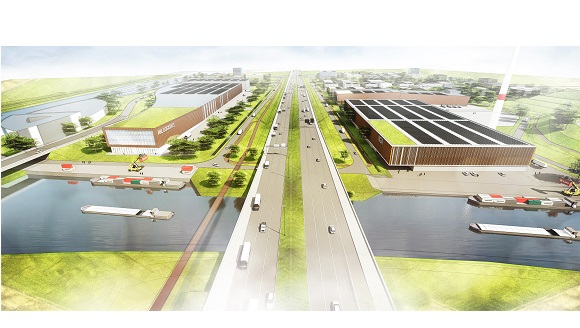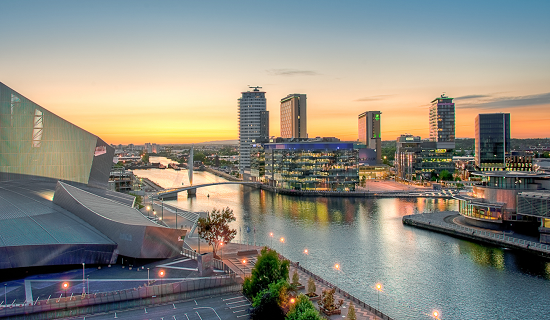Sustainable urban growth needs careful planning and early community engagement. The contributions of a multitude of stakeholders must be co-ordinated and competing demands and cost constraints balanced – it is no easy task.
As an aid to dealing with these wide ranging complexities, urban developers are increasingly using standards to help ensure that community-scale developments are sustainable, not only in terms of environmental impacts but also economically and socially.
 ©Eiland Zwijnaarde NV and Waterwegen & Zeekanaal NV
©Eiland Zwijnaarde NV and Waterwegen & Zeekanaal NV
BREEAM Communities
One such standard is BREEAM Communities which is used to improve, measure and certificate the social, environmental and economic sustainability of large-scale developments by integrating sustainability into the design and planning (master planning) process.
BREEAM Communities provides a framework in which developers, local authorities and master planning professionals can work together – with the full involvement of the community – to set the vision and ambition for a development.
“BREEAM Communities is a planning vehicle but is actually so much more,” says Iain Taylor, Partnerships Director, Peel Group, “20% of the value is in the planning and 80% is in the conversation you have about your development, how that team works and how that subsequent development expresses itself.” The Peel Group has been applying BREEAM Communities to the MediaCityUK development, a major regeneration project on a waterfront site at Salford Quays in Manchester.
The BREEAM Communities standard is not only being applied in the UK, where it aligns with the current UK planning process and uses the core principles of national planning policy, but also in Europe and the Middle East, where a bespoke process is used, through which the scheme is adapted to reflect the local context.
 ©Peel GroupU
©Peel GroupU
Tech Lane Ghent
One of the most recent European developments to make use of BREEAM Communities is the Tech Lane Ghent Business Park in Belgium. Located in southern Ghent, this 60 hectares site will include 35.7 hectares for a science park that can accommodate knowledge-intensive firms in sectors such as IT, life sciences and materials research, along with a business logistics park on the site’s waterfront. 24.2 hectares will be dedicated to green space – both along the river bank and as green corridors throughout the development.
Tech Lane Ghent’s developers, Eiland Zwijnaarde NV and Waterwegen & Zeekanaal NV, have ambitious sustainability goals – as does the city of Ghent – in areas such as energy and water use, landscaping and transport. BREEAM Communities, being led by assessor company BOPRO, has provided an authoritative reference of sustainability best practice, and will act as an internationally recognised benchmark for potential tenants looking for sustainable workplaces.
Contaminated land
One example of its impact involves the contamination of the site’s land as a result of earlier industrial use – a common problem in urban regeneration projects. BREEAM Communities certification will reassure the Business Park’s occupants and visitors that this issue has been properly and sustainably dealt with. In addition – in line with the outcome of community consultation – an area identified as unfit for buildings is being used to create a landscaped hill that will provide a focal point for the community.
Exploiting a transport ‘barrier’
Another key issue for this site is that of transport – it is on the outskirts of the city and is remote from most public transport links. BREEAM Communities is providing a framework for the discussions over the provision of transport, which will include extensive cycling facilities.
One unusual aspect at Tech Park Ghent is the fact that it is an ‘island’ surrounded by waterways. This potential transport barrier to the site will be turned into an advantage by developing the waterways for a range of transport uses, including the movement of goods for the logistics park and the possible introduction of water taxis.
About BREEAM Communities
BREEAM Communities is part of the BREEAM family of standards which are used in more than 70 countries. The world’s foremost environmental assessment and rating system for buildings and communities, more than 425,000 certificates have been issued under BREEAM on more than 24,000 projects around the world. BREEAM assessments are conducted by an international network of independent, licensed assessors and auditors. BREEAM Communities has been specifically designed for large urban developments. Itprovides a common framework that encourages collaboration between key stakeholders, thus building consensus and supporting a more sustainable outcome.

Wednesday, 24 June 2015
Urban Trends and BREEAM Communities
One of the most striking world trends in urban development is the extraordinary pace of city growth, with an estimated 1.3 million more people living in urban areas every week . This rapid urbanisation requires the expansion and regeneration of our cities, which presents an opportunity to develop high quality, sustainable communities.















